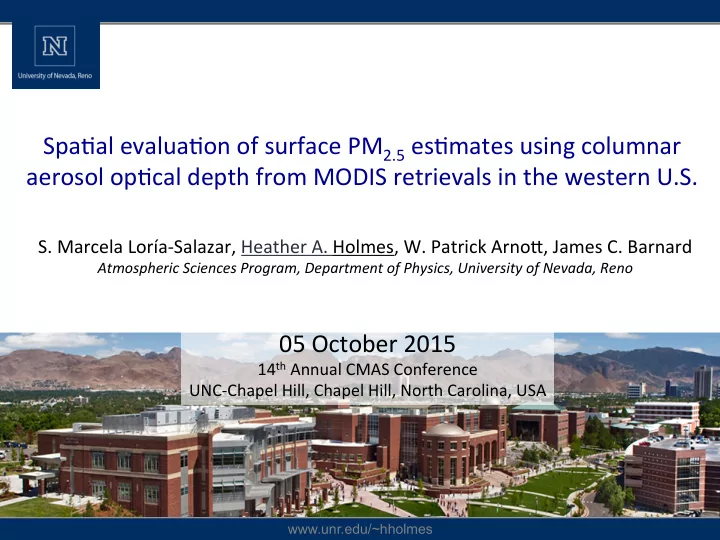

SpaLal ¡evaluaLon ¡of ¡surface ¡PM 2.5 ¡esLmates ¡using ¡columnar ¡ aerosol ¡opLcal ¡depth ¡from ¡MODIS ¡retrievals ¡in ¡the ¡western ¡U.S. ¡ S. ¡Marcela ¡Loría-‑Salazar, ¡Heather ¡A. ¡Holmes, ¡W. ¡Patrick ¡ArnoH, ¡James ¡C. ¡Barnard ¡ Atmospheric ¡Sciences ¡Program, ¡Department ¡of ¡Physics, ¡University ¡of ¡Nevada, ¡Reno ¡ 05 ¡October ¡2015 ¡ 14 th ¡Annual ¡CMAS ¡Conference ¡ UNC-‑Chapel ¡Hill, ¡Chapel ¡Hill, ¡North ¡Carolina, ¡USA ¡ www.unr.edu/~hholmes
Motivation to The in an 3). to 1a in in the 24- hy ity lic Figure 1a. Time series of hourly PM2.5 • Human health impacts of wildfire smoke exposure • Visibility and radiative forcing impacts for climate • Increasing drought conditions in western U.S. = more fires 2 www.unr.edu/~hholmes
Motivation 70km 70km 70km King Fire 2014 Rim Fire 2013 Chips Fire 2012 Terra- 17 Sep 2014 Aqua - 3 Aug 2012 Aqua –22 Aug 2013 Uncertainties in aerosol optical depth ( AOD ) satellite remote sensing algorithm • Uniformly mixed aerosols of homogeneous composition • All aerosols are contained within the boundary layer • Surface reflectance: Dark Target (dark) & Deep Blue (bright) 3 www.unr.edu/~hholmes
Objectives and Hypotheses Objectives • Determine uncertainty of satellite AOD using ground-based AOD • Investigate the relationship between columnar AOD & PM 2.5 • Use models and upper air data to understand aerosol transport from wildfire smoke plumes • Develop daily, spatially-resolved surface PM concentration fields Hypotheses • Complex atmospheric transport will lead to uncertainties in satellite retrieval algorithms • Columnar AOD and surface PM 2.5 will not be linearly correlated • Wildfire smoke will improve sensitivity of satellite retrieval 4 www.unr.edu/~hholmes
Approach • Collect MODIS satellite retrievals for AOD • Collect NASA AERONET ground-based sunphotometry AOD data • Collect PM 2.5 concentration data from monitoring networks • Collect balloon sounding data • UNR Photoacoustic and Integrated Nephelometer (PIN) measurements • Evaluate spatial satellite retrivals for AOD using AERONET data • Investigate atmospheric physics using balloon and PIN data Cimel CE-318 Sun photometer Photoacoustic and Integrated Nephelometer Beta Attenuation Monitor (PM 2.5 ) 5 www.unr.edu/~hholmes
Satellite Domain and AOD Monitors Satellite Domain AERONET Locations Reno San Francisco Fresno Las Vegas Los Angeles San Diego • 10-‑km ¡horizontal ¡resoluLon ¡ • 12 ¡ AOD ¡monitors ¡ • One ¡swath ¡two ¡Lmes ¡per ¡day ¡ • Hourly ¡data ¡during ¡daylight ¡ 6 www.unr.edu/~hholmes
Spatial R 2 and Normalized Mean Bias (NMB) Terra (AM): Three Years, Non-fire Periods Dark Target Deep Blue 1 1 0.8 0.8 Correlation (R 2 ) 0.6 0.6 0.4 0.4 0.2 0.2 0 0 >200 >80 140 50 60 20 Bias (NMB %) 0 0 -60 -20 -140 -50 <-200 <-80 7 www.unr.edu/~hholmes
Spatial R 2 and Normalized Mean Bias (NMB) Terra (AM): Three Years, Fire Periods Dark Target Deep Blue 1 1 0.8 0.8 Correlation (R 2 ) 0.6 0.6 0.4 0.4 0.2 0.2 0 0 >140 >250 100 150 40 50 Bias (NMB %) 0 0 -50 -40 -150 -100 <-250 <-140 8 www.unr.edu/~hholmes
Reno: AERONET versus MODIS AOD Dark Target Deep Blue • Deep Blue for bright surfaces, Reno = Desert • Deep Blue under predicts AOD for fire periods 9 www.unr.edu/~hholmes
Fresno: AERONET versus MODIS AOD Dark Target Deep Blue • Deep Blue better correlation, Fresno = Desert? • Deep Blue under predicts AOD for fire periods 10 www.unr.edu/~hholmes
Convective Boundary Layer Height ( CBLH ) Free Atmosphere Height (m) Residual Layer Convective Mixed Layer CBLH Surface Layer Stable Boundary Layer 5PM Sunrise Noon Sunset Midnight Local Time 11 www.unr.edu/~hholmes
Apparent Optical Height ( AOH ) Estimates the height that aerosols can reach in the atmosphere • In-situ photoaccoustic and reciprocal nephelometer: Surface β ext • Ground-based sunphotometry: Columnar AOD ( τ ext ) Raman Lidar Picture of the Convective Mixed Layer at the DOE ARM site in North Central Oklahoma. (Courtesy of Dr. David Turner) 12 www.unr.edu/~hholmes
Vertical Profiles: CBLH and AOH 13 www.unr.edu/~hholmes
MODIS AOD: August 2013 - Rim Fire Dark Target Deep Blue AM AM PM PM 14 www.unr.edu/~hholmes
Reno: PM 2.5 , AERONET and MODIS AOD 15 www.unr.edu/~hholmes
Fresno: PM 2.5 , AERONET and MODIS AOD 16 www.unr.edu/~hholmes
HYSPLIT Back Trajectories: 31 Aug 2013 24 hour, NAM 12-km Reno Reno: 100m & 2000m near plume Fresno: 4000m & 5000m Fresno near plume 100m & 200m west of plume, clean air 17 www.unr.edu/~hholmes
MODIS AOD: September 2014 - King Fire Dark Target Deep Blue AM AM PM PM 18 www.unr.edu/~hholmes
Reno: PM 2.5 , AERONET and MODIS AOD 19 www.unr.edu/~hholmes
HYSPLIT Back Trajectories: 9 Sep 2014 Reno 24 hour, NAM 12-km MODIS 19 th 10:00 10:00 MODIS 19 th 13:00 MODIS 19 th 13:00 16:00 13:00 www.unr.edu/~hholmes 20
Conclusions Summary • AOD satellite retrievals have high uncertainty in the western U.S. due to complex terrain, bright surface, heterogeneous aerosol profiles • Aerosols above the CBL, enhanced by smoke plume injection above CBL • Wildfire smoke improves the correlation between AERONET & MODIS but does not improve the bias • Surface PM 2.5 is not linearly correlated with columnar AOD Future Directions • Data fusion of MODIS AOD and PM 2.5 observations, with and [AGU] without calibration using AERONET to estimate surface PM 2.5 • Statistically quantify uncertainties in MODIS AOD using AERONET [AGU] data, and attribute to parameterizations in retrieval algorithm • Use spatial surface PM 2.5 concentrations to estimate wildfire smoke exposure in California and Nevada www.unr.edu/~hholmes 21
Recommend
More recommend